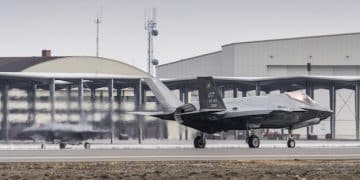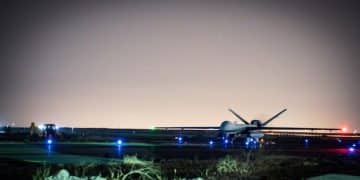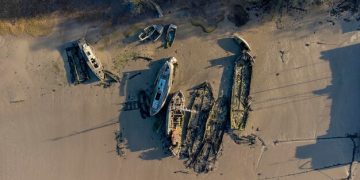Defense Industry Market Trends: Key Drivers Shaping Future Security

The defense industry’s market trends over the next five years will be predominantly shaped by escalating geopolitical tensions, rapid technological advancements like AI and hypersonics, and evolving procurement priorities focused on resilience and interoperability.
Exploring the complex landscape of Defense Industry Market Trends: What are the Key Drivers Shaping the Future of the Sector in the Next 5 Years? is essential for understanding global security and economic forces. The next half-decade promises a dynamic transformation, driven by an intricate web of geopolitical shifts, technological breakthroughs, and evolving strategic priorities that will redefine military capabilities and international relations.
Geopolitical Shifts and Escalating Tensions
The global geopolitical landscape is undergoing a profound transformation, characterized by increased volatility and a re-emergence of great power competition. This environment directly fuels demand within the defense industry, as nations seek to bolster their security and project influence in an uncertain world. Regions such as Eastern Europe, the Indo-Pacific, and the Middle East remain hotspots, requiring constant vigilance and advanced military preparedness.
The conflict in Ukraine, for instance, has significantly reshaped European defense policies, leading to increased defense spending and a renewed emphasis on conventional deterrence. Similarly, tensions in the South China Sea and across the Taiwan Strait continue to prompt significant investments in naval and air power by regional actors and their strategic partners. These localized flashpoints often have global implications, influencing military doctrines and procurement cycles far beyond their immediate borders.
The Return of Great Power Competition
The rivalry between established powers and rising nations necessitates a re-evaluation of defense strategies. This competition manifests not only in traditional military buildup but also across cyber and space domains. Nations are increasingly investing in capabilities that offer asymmetric advantages, recognizing that future conflicts may not be fought exclusively on land, sea, or air. This competitive environment encourages innovation and the rapid deployment of cutting-edge technologies.
- Increased defense budgets in NATO countries and key Indo-Pacific allies.
- Focus on rapid deployment capabilities and logistical resilience.
- Development of advanced long-range precision strike systems.
- Emphasis on integrated air and missile defense systems.
The perceived threat level, whether from state actors or non-state entities, dictates the pace and direction of defense spending. Moreover, the interconnectivity of global economies means that instability in one region can have ripple effects, encouraging a collective security approach among allies. This collective approach often translates into joint development programs and interoperability initiatives, further shaping market demands.
Regional Instability and Hybrid Warfare
Beyond great power dynamics, persistent regional instabilities and the rise of hybrid warfare tactics present complex challenges. These include insurgency, terrorism, cyberattacks, and information warfare, often blurring the lines between conflict and peace. Nations must equip their forces not only for conventional threats but also for ambiguous and constantly evolving engagements that require adaptable and technologically superior solutions.
The demand for intelligence, surveillance, and reconnaissance (ISR) technologies, cyber-defense capabilities, and specialized training for irregular warfare is growing. This shift emphasizes the need for versatile platforms and systems that can operate effectively across multiple domains and against diverse threats. The integration of civilian and military technologies, or “dual-use” technologies, also becomes pivotal in addressing these evolving forms of conflict and maintaining a strategic edge.
In essence, the volatile geopolitical climate acts as a primary driver for defense industry growth, forcing nations to continually upgrade their defense postures and seek advanced solutions for both traditional and emergent threats. This ongoing demand ensures a consistent pipeline for defense contractors and research institutions, fostering innovation and competitive development in the sector.
Technological Advancements and Disruptive Innovations
The defense sector is on the cusp of an unparalleled technological revolution, with advancements in artificial intelligence, autonomous systems, hypersonic capabilities, and quantum computing poised to redefine military operations. These innovations promise to enhance operational efficiency, reduce human risk, and deliver unprecedented precision and speed, creating both opportunities and challenges for traditional defense contractors.
Artificial intelligence, in particular, is moving beyond theoretical applications to practical deployment across various military functions, from predictive maintenance to advanced target recognition and decision support systems. Its integration is expected to significantly improve situational awareness and the speed of response on the battlefield. Similarly, autonomous systems, including unmanned aerial vehicles (UAVs) and ground vehicles (UGVs), are becoming indispensable assets for surveillance, reconnaissance, and even direct combat roles, minimizing human exposure to high-risk environments.
Artificial Intelligence and Autonomous Systems
The integration of AI is transforming military decision-making, logistics, and combat operations. AI algorithms are being developed to process vast amounts of data, identify patterns, and predict adversary movements, providing commanders with critical insights. Autonomous systems, from combat drones to underwater vehicles, offer persistent presence and precision strike capabilities without endangering human lives. The ethical implications and regulatory frameworks surrounding these technologies are also rapidly evolving.
- Enhanced data analysis for intelligence and reconnaissance.
- Development of AI-powered predictive maintenance for military assets.
- Increased deployment of unmanned aerial and ground systems for various missions.
- Focus on human-machine teaming to augment soldier capabilities.
The ability of AI to learn and adapt on the fly provides a significant tactical advantage, leading to a race among major powers to achieve superiority in this domain. Moreover, the proliferation of AI in defense is not limited to frontline combat; it extends to logistical support, cybersecurity, and even personnel training, promising a more efficient and responsive military apparatus.
Hypersonic Weapons and Advanced Materials
The development of hypersonic weapons represents a paradigm shift in conventional warfare, offering the ability to strike targets anywhere on Earth within minutes, with unparalleled agility and precision. This technology challenges existing missile defense systems and is a top priority for several leading military powers. Concurrently, advancements in materials science are leading to the creation of lighter, stronger, and more resilient components for aircraft, vessels, and protective gear.
These new materials not only improve the performance and durability of military platforms but also reduce their logistical footprint and operational costs. From advanced ceramics for armor to composite structures for stealth aircraft, materials innovation underpins the next generation of defense capabilities, ensuring that platforms can withstand increasingly sophisticated threats while maintaining a competitive edge in speed and agility.
Cyber Warfare and Quantum Technologies

Cyber warfare is now recognized as a critical domain of conflict, with nations investing heavily in offensive and defensive cyber capabilities to protect critical infrastructure and disrupt adversary operations. The cyber domain extends beyond traditional networks to include supply chain security and the integrity of data within military systems. As this domain evolves, the importance of robust cybersecurity measures becomes paramount.
Looking further ahead, quantum technologies, particularly quantum computing and quantum cryptography, hold the potential to revolutionize intelligence gathering, communication security, and even sensor capabilities. While still in early stages of military application, these technologies promise to offer unbreakable encryption and computational power far beyond current capabilities, signaling a new frontier in defense innovation. The strategic implications of quantum supremacy are driving significant research and development efforts globally.
The relentless pace of technological advancement not only shapes what is possible in defense but also creates an imperative for nations to continually adapt and invest to maintain a competitive advantage. This dynamic ensures technology remains a core driver for market trends in the defense industry for the foreseeable future.
Evolving Procurement Priorities and Supply Chain Resilience
The global defense landscape is not just shaped by what cutting-edge technologies are available, but crucially, by how and what nations choose to procure. Evolving threats, lessons from recent conflicts, and the growing emphasis on national security independence are driving significant shifts in procurement priorities. There’s a heightened focus on platforms that offer versatility, interoperability with allies, and, increasingly, resilience across complex supply chains.
Gone are the days when sheer quantity was the sole measure of military strength. Modern procurement strategies prioritize quality, technological superiority, and the ability to rapidly adapt to dynamic conflict environments. This means a move away from costly, single-purpose hardware towards more flexible, software-defined systems that can be updated and reconfigured to meet emerging threats. Furthermore, the COVID-19 pandemic and recent geopolitical events have underscored the fragility of global supply chains, pushing nations to diversify sources, localize production, and build redundancies to ensure critical defense components are always available.
Interoperability and NATO Standardization
For allied nations, especially those within NATO or similar security pacts, interoperability is no longer a luxury but a fundamental requirement. The ability of different national forces to operate seamlessly together, sharing intelligence, logistics, and even ammunition, is critical for effective combined operations. This drives demand for standardized equipment, common communication protocols, and joint training exercises.
- Increased emphasis on joint procurement programs among allied nations.
- Demand for systems with open architectures that facilitate integration.
- Prioritization of common ammunition types and weapon systems for logistical ease.
- Development of shared intelligence platforms for enhanced situational awareness.
Procurement decisions are increasingly influenced by a platform’s ability to “plug and play” with existing allied systems, ensuring cohesion and maximizing the collective deterrent effect. This also creates a market for defense contractors capable of developing versatile and adaptable solutions that meet diverse international standards.
Emphasis on Resilience and Domestic Production
Recent global disruptions have highlighted the vulnerabilities of extended supply chains. As a result, nations are placing a greater emphasis on supply chain resilience, seeking to reduce dependence on foreign suppliers for critical components, especially those related to advanced technologies. This trend favors domestic production capabilities and strategic stockpiling, supporting local defense industries and fostering self-sufficiency.
Governments are incentivizing in-country manufacturing, research and development, and the acquisition of intellectual property to ensure a secure and reliable supply of defense materials. This not only bolsters national security but also creates domestic jobs and stimulates technological innovation within the country. The demand for robust risk management strategies across the defense supply chain is also growing, including diversification of suppliers and geographical redundancy.
Modular Design and Software-Defined Systems
The future of defense procurement leans heavily towards modular design and software-defined systems. These approaches allow for greater flexibility, easier upgrades, and extended operational lifespans of military assets. Instead of waiting for entirely new platforms, militaries can update capabilities through software enhancements or by integrating new modules, making their forces more agile and cost-effective over time.
This shift influences the entire defense ecosystem, from research and development to manufacturing and sustainment. It encourages a move towards iterative development cycles and fosters closer collaboration between hardware manufacturers and software developers. The ability to rapidly deploy software patches or new features mitigates the risk of technological obsolescence, ensuring long-term relevance of defense investments.
In summary, evolving procurement priorities underscore a strategic pivot towards adaptability, resilience, and collaborative capabilities, profoundly influencing the types of defense solutions that will dominate the market in the coming years.
Sustainability and Environmental Considerations
While often associated with heavy industry and significant resource consumption, the defense sector is increasingly acknowledging and integrating sustainability principles into its operations and procurement strategies. This shift is not merely about environmental responsibility; it’s a pragmatic response to climate change’s impact on military operations, regulatory pressures, and the desire for more efficient, cost-effective solutions. The future of defense will likely see a significant push towards greener technologies, reduced carbon footprints, and sustainable resource management.
Climate change poses direct threats to military installations and operations, from rising sea levels affecting naval bases to extreme weather events disrupting training and deployment. Furthermore, the defense sector is a large energy consumer, and transitioning to more sustainable energy sources can enhance operational independence and reduce logistical vulnerabilities. This recognition is driving investment in renewable energy for bases, electric and hybrid military vehicles, and more efficient propulsion systems for aircraft and vessels.
Reducing Carbon Footprint and Energy Efficiency
Defense organizations worldwide are setting ambitious targets to reduce their carbon footprint. This extends to every aspect of operations, from energy consumption on bases to fuel efficiency of vehicles and aircraft. Innovations in propulsion systems, such as hybrid-electric drives for ships and more fuel-efficient engines for air platforms, are becoming key areas of research and development.
- Investment in renewable energy sources for military bases.
- Development of more fuel-efficient and alternative-fuel vehicles.
- Exploration of compact nuclear power for naval applications.
- Implementation of energy-saving technologies in facilities and equipment.
The adoption of smart grids and energy storage solutions at military installations ensures not only a greener operation but also enhanced energy security and resilience against grid failures, a critical factor in maintaining operational readiness. This commitment to efficiency also translates into cost savings over the long term, making it an attractive proposition for defense ministries.
Sustainable Manufacturing and Supply Chains
The push for sustainability extends to the entire defense supply chain. Defense contractors are increasingly under pressure to adopt sustainable manufacturing practices, reduce waste, and manage resources responsibly. This includes using recycled materials, implementing efficient production processes, and minimizing hazardous waste. Ethical sourcing of raw materials, particularly those from conflict zones or extracted with significant environmental impact, is also gaining prominence.
Companies that can demonstrate robust environmental, social, and governance (ESG) credentials are more likely to secure lucrative defense contracts, as governments integrate sustainability criteria into their procurement policies. This creates a market advantage for firms that prioritize environmental stewardship and responsible business practices throughout their value chain.
Impact of Climate Change on Military Operations

Beyond reducing its own impact, the military is also preparing for the operational consequences of climate change. This includes developing capabilities for humanitarian assistance and disaster relief (HADR) in response to more frequent and intense climate-induced events. It also means adapting infrastructure to withstand changes in sea levels, extreme temperatures, and altered weather patterns.
Arctic operations, for example, are becoming more relevant as melting ice opens new shipping lanes and access to natural resources, requiring adapted military platforms and training. This operational adaptation stimulates demand for specialized equipment designed to function effectively in extreme and changing environmental conditions. The intersection of environmental challenges and defense needs is creating a new frontier for innovation within the industry.
The drive towards sustainability is transforming the defense industry from within, promoting a more responsible and resilient approach to military readiness in the face of global environmental challenges.
Global Economic Factors and Budgetary Pressures
The defense sector, deeply intertwined with national economies, is inherently sensitive to global economic trends and fluctuating budgetary pressures. While geopolitical tensions often drive increased defense spending, periods of economic uncertainty or recessions can impose significant constraints. Navigating this dynamic requires defense ministries and contractors alike to prioritize efficiency, justify expenditures, and often seek innovative financing models.
Inflation, interest rates, and national debt levels play a crucial role in determining the fiscal headroom available for defense investments. Historically, economic downturns have led to austerity measures that impact military procurement, forcing harder choices about what technologies to prioritize and which programs to reduce or delay. Conversely, periods of economic growth can unlock significant investment, accelerating the development and deployment of advanced systems. The challenge lies in balancing long-term strategic needs with short-term fiscal realities.
Inflation and Supply Chain Costs
Rising inflation directly impacts the cost of raw materials, labor, and energy, increasing the overall expense of defense programs. This can lead to budget overruns, fewer units procured, or delays in project completion, challenging defense ministries to achieve their objectives within allocated funds. Supply chain disruptions, often exacerbated by geopolitical events, further compound these cost pressures, making reliable cost forecasting more complex.
- Escalating costs of critical raw materials like rare earth minerals and specialized alloys.
- Increased labor costs due to skilled workforce shortages.
- Higher energy prices impacting manufacturing and operational costs.
- Need for stringent cost controls and value engineering in defense projects.
Defense contractors are exploring strategies such as long-term contracts with fixed prices for key components, greater automation in manufacturing, and increased vertical integration to mitigate these inflationary effects. The ability to manage costs effectively becomes a significant competitive advantage in this environment.
National Debt and Budgetary Constraints
Many nations are grappling with significant national debt accumulated from various global crises, including the pandemic. This often leads to difficult trade-offs in public spending, where defense budgets may compete with essential social programs, healthcare, and education. Such constraints necessitate a focus on cost-effectiveness, smart investment, and a clear articulation of defense spending’s value proposition to taxpayers.
Governments may opt for phased procurement, upgrade existing platforms rather than acquiring new ones, or increase reliance on foreign military sales to offset domestic production costs. Lobbying efforts by defense industries become more intense, emphasizing the economic benefits of defense spending through job creation and technological spin-offs.
Impact of Global Economic Slowdowns
A global economic slowdown can lead to reduced tax revenues and increased pressure on government budgets, directly impacting defense allocations. During such periods, defense ministries often face mandates to find efficiencies, consolidate programs, and divest non-essential assets. This can slow the pace of modernization and hinder long-term strategic planning.
However, some argue that defense spending can act as a counter-cyclical measure, stimulating innovation and employment during economic downturns. This perspective, though not universally accepted, suggests that strategic defense investments can contribute to economic recovery and technological advancement, potentially buffering some of the negative effects of a slowdown. The balance between fiscal prudence and strategic necessity remains a critical tension point for defense policy makers.
Understanding these economic currents is vital, as they directly influence the scale, scope, and direction of defense market trends, demanding agility and strategic foresight from all stakeholders.
Cybersecurity and Information Dominance
In the evolving landscape of global security, the battle for cybersecurity and information dominance has ascended to a primary concern for defense establishments worldwide. Beyond traditional military hardware, the ability to protect critical digital infrastructure, gather, process, and disseminate information securely, and influence narratives has become a decisive factor in modern conflict. This emphasis on the digital realm is driving significant investment and innovation within the defense industry.
Nations are increasingly aware that a sophisticated cyberattack can cripple military operations, intelligence gathering, or even national critical infrastructure without firing a single shot. Consequently, there’s an urgent need for robust defensive capabilities to thwart state-sponsored hacking, ransomware, and espionage. Conversely, offensive cyber capabilities are seen as essential tools for reconnaissance, disruption, and achieving asymmetric advantages against adversaries, ensuring information superiority on the digital battlefield.
Protecting Critical Infrastructure
The interconnectedness of military and civilian infrastructure means that cyber threats to one can quickly impact the other. Protecting critical installations, supply chains, and communication networks from cyber intrusions is paramount. This involves developing sophisticated detection systems, rapid response protocols, and resilience strategies to ensure continuity of operations even under attack.
- Implementation of advanced threat detection and prevention systems.
- Regular vulnerability assessments and penetration testing of networks.
- Investment in secure communication technologies and encrypted channels.
- Development of cyber-resilience frameworks for essential services.
The defense industry is responding with an array of specialized cybersecurity solutions, from secure cloud environments to artificial intelligence-powered threat analysis tools. The demand for skilled cybersecurity professionals within both government and defense contractor ranks is also rapidly escalating, highlighting a critical talent gap.
Information Warfare and Disinformation
Beyond direct cyberattacks, information warfare, including the spread of disinformation and propaganda, is a growing concern. Nations are investing in capabilities to counter false narratives, protect their own information integrity, and, in some cases, engage in information operations to shape perceptions. This requires a fusion of traditional intelligence gathering with open-source analysis and sophisticated digital tools.
Understanding and influencing the information environment is seen as crucial for maintaining strategic advantage and winning the support of populations, both domestically and internationally. This aspect of information dominance also intersects with social media analysis and the monitoring of digital platforms for potential threats or influence campaigns.
Quantum Cryptography and Secure Communications
Looking ahead, the development of quantum computing poses a potential threat to current encryption standards, making quantum-resistant cryptography a burgeoning area of defense research. Quantum cryptography promises “unhackable” communication channels, offering a future-proof solution for securing sensitive military data and intelligence exchanges.
While still largely in the research phase, the long-term implications of quantum technologies for defense communications are profound. Nations investing early in this field aim to achieve a decisive advantage in secure information exchange, safeguarding their most critical secrets and operational plans from even the most advanced adversaries. The race for quantum security is a quiet but intense component of the broader information dominance struggle.
The persistent and evolving threat landscape in the digital domain ensures that cybersecurity and information dominance will remain central pillars of defense industry market trends, driving continuous innovation and significant investment in the tools and talent necessary for victory in the information age.
Space-Based Capabilities and Satellite Technology
The domain of space is no longer merely a frontier for scientific exploration; it has become an indispensable and increasingly contested arena for military operations, intelligence gathering, and global communication. The reliance on space-based capabilities, particularly satellite technology, for virtually every aspect of modern defense is driving a rapid expansion and diversification of the space defense market. This trend is fueled by strategic competition, the proliferation of anti-satellite weapons, and the imperative for resilient space architectures.
Satellites provide critical functions ranging from detailed reconnaissance and precision navigation (GPS) to secure global communications and missile warning systems. Their vulnerability, however, has led to a race among major powers to develop more robust, resilient, and potentially offensive capabilities in space. This includes investments in smaller, more agile satellite constellations, advanced ground control systems, and counter-space technologies designed to deny adversaries the use of their own orbital assets.
Constellations for Enhanced Coverage and Resilience
The trend is shifting from a few large, expensive, and vulnerable satellites to constellations of numerous smaller, more affordable, and resilient satellites. These distributed constellations offer enhanced coverage, reduced latency, and a greater ability to withstand attacks or system failures. If one satellite is compromised, others can take over its function, ensuring continuity of service critical for military operations.
- Deployment of low-Earth orbit (LEO) satellite constellations for high-speed connectivity.
- Development of rapid-reconstitution capabilities for damaged or destroyed satellites.
- Focus on redundancy and diversification in satellite types and orbits.
- Integration of AI for autonomous satellite operation and constellation management.
Defense contractors are increasingly specializing in the design, launch, and management of these complex satellite networks. The demand for advanced propulsion systems, miniaturized components, and secure data links for these constellations is expected to remain high in the coming years.
Anti-Satellite (ASAT) Capabilities and Space Situational Awareness
The development of anti-satellite (ASAT) weapons, capable of disrupting, disabling, or destroying orbital assets, highlights the weaponization of space. This necessitates strong defensive measures and sophisticated space situational awareness (SSA) systems to track objects in orbit, detect potential threats, and predict orbital movements.
Investing in SSA is paramount for protecting national space assets and ensuring freedom of operation in space. This includes advanced ground-based radars, optical telescopes, and in-orbit sensors that provide a comprehensive picture of the space environment. The ability to identify and characterize threats in space is crucial for deterrence and defensive maneuvers.
Commercial Space Integration and Dual-Use Technologies
The rapid growth of the commercial space industry, particularly in areas like launch services, satellite imagery, and broadband connectivity, offers significant opportunities for defense applications. Militaries are increasingly leveraging commercial capabilities to augment their own systems, reducing costs and accelerating deployment.
Dual-use technologies, originally developed for commercial purposes but with significant military applications, are also driving innovation. This collaboration between the commercial and defense sectors in space is fostering a more dynamic and competitive environment, spurring rapid advancements and providing diverse solutions for tactical and strategic needs. The integration of commercial space analytics and data is particularly valuable for intelligence and reconnaissance missions, providing high-resolution imagery and real-time data that complements traditional military collection methods.
Ultimately, the escalating importance of space for national security guarantees its continued prominence as a key driver of market trends within the defense industry.
| Key Driver | Brief Description |
|---|---|
| 🌍 Geopolitical Shifts | Rising global tensions and conflicts directly fuel demand for enhanced defense capabilities. |
| 💡 Technological Innovations | AI, hypersonics, and autonomous systems are reshaping military strategies and procurement. |
| 🔗 Supply Chain Resilience | Focus on diversifying sources and increasing domestic production for strategic self-reliance. |
| 🛰️ Space-Based Capabilities | Increased reliance on and competition in space for intelligence, communication, and warfare. |
Frequently Asked Questions About Defense Market Trends
Geopolitical shifts, particularly the re-emergence of great power competition and regional conflicts, are directly accelerating defense spending globally. Nations are investing more in modernizing their forces, enhancing deterrence capabilities, and ensuring readiness across various domains, including conventional, cyber, and space warfare, in response to increased instability and perceived threats.
Artificial intelligence, autonomous systems (drones), hypersonic weapons, and advanced material science are among the most influential technological innovations. These technologies promise to revolutionize military capabilities by enhancing precision, speed, and efficiency, and by reducing human risk in combat zones, fundamentally reshaping future warfare scenarios and defense procurement.
Supply chain resilience is a growing priority due to recent global disruptions, like the pandemic and geopolitical events, which exposed vulnerabilities. Nations now prioritize diversifying suppliers, reducing dependency on foreign sources for critical components, and boosting domestic production to ensure uninterrupted access to essential defense materials and technologies, bolstering national security.
Economic factors such as inflation, national debt, and global slowdowns directly impact defense budgets. While geopolitical tensions might necessitate increased spending, economic constraints can force difficult choices, leading to delayed procurements or a focus on cost-effective upgrades. The industry must balance strategic needs with fiscal realities, driving demand for innovative, efficient solutions.
Space-based capabilities are increasingly critical for intelligence, communication, navigation, and missile warning. The future will see more resilient satellite constellations and advanced anti-satellite technologies. Nations are investing heavily to secure access to and dominance in space, as it is an indispensable and increasingly contested domain for modern military operations and global security.
Conclusion
The defense industry stands at a pivotal juncture, profoundly influenced by a confluence of accelerating geopolitical shifts, groundbreaking technological advancements, and evolving strategic priorities. The next five years will undoubtedly witness a continued surge in demand for sophisticated military capabilities, driven by the imperative for nations to secure their interests in an increasingly complex and uncertain world. From the re-emergence of great power competition to the exigencies of cybersecurity and space dominance, each driver underscores a fundamental reshaping of defense strategies. As the sector continues to adapt to these dynamic forces, it will not only redefine national security postures but also spur innovation that extends far beyond the traditional confines of military applications, demonstrating its critical role in shaping global stability and technological progress.





